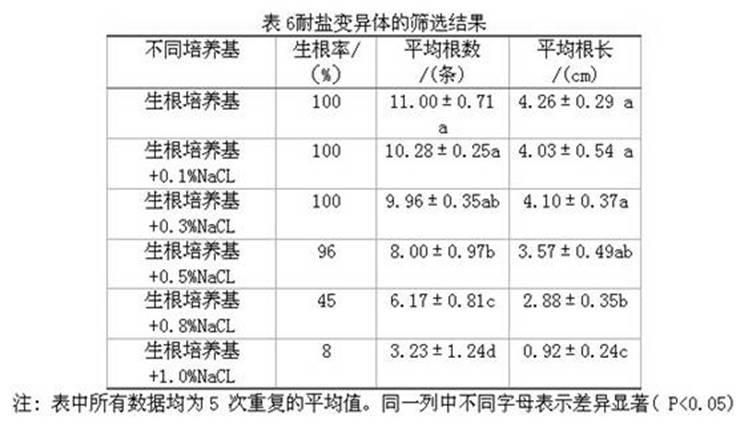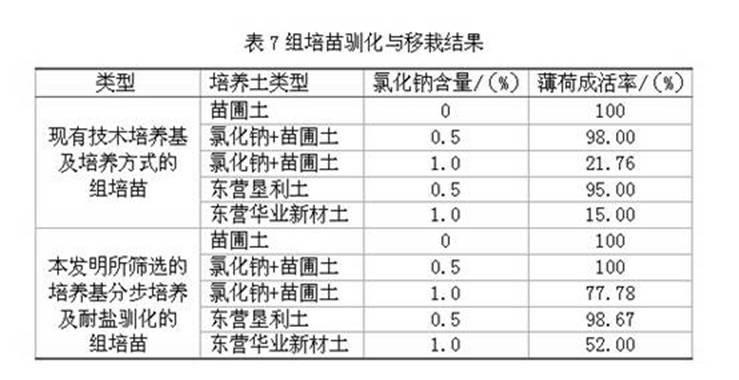Tissue culture and rapid propagation method of salt-tolerant field mint
A tissue culture rapid propagation, salt-tolerant technology, applied in the field of agricultural biology
- Summary
- Abstract
- Description
- Claims
- Application Information
AI Technical Summary
Problems solved by technology
Method used
Image
Examples
Embodiment 1
[0029] Embodiment 1. The establishment of the explant sterile line adopts the method that the stem sections of different growth stages are sterilized separately
[0030] Take the vigorously growing mint plants from the nursery, remove the leaves and leave the stems and buds, rinse with running water for 20 minutes, absorb the water with filter paper, trim the explants with surgical scissors, cut off 3 cm long stems, and then divide the Stem segments (stem tip, middle stem segment, base stem segment) are separated and set aside. After sterilizing with 75% alcohol solution for 10s-60s and 0.1% mercuric chloride solution for 8-15 minutes on the ultra-clean workbench, rinse it with sterile water for 4-5 times, blot the water and then use surgical scissors to clean the explants. Trim, remove the black parts at both ends, then inoculate it in 1 / 2MS medium, and place it in a light incubator for cultivation. After 3 days, the pollution situation of the plants was observed, and the po...
Embodiment 2
[0032] Embodiment 2: Tissue culture formula screening
[0033] 2.1 Screening of callus induction medium (see Table 2, Table 3).
[0034] Orthogonal test L4(2 3 )filter. Select 3 cm long robust sterile seedlings and place them in the culture medium to induce callus. After 30 days of culture, the callus induction rate was investigated. Callus induction rate = number of stem callus / number of inoculated stems × 100%.
[0035] It can be seen from Table 3 that the orthogonal optimal formula is A (1,2) B 1 C 2 , namely 1 / 2MS or 2 / 3MS, 1.0 mg·L - 1 6-BA, 0.2mg·L - 1 NAA, 30g L -1 Sucrose and 4 g·L -1 GEL. It can be seen from the R value that NAA (C) is an important factor, 6-BA (B) is also a more important factor, and MS (A) is a less influential factor, that is, the influencing factor C>B>A. Therefore, this test determined that NAA was an important factor in the ability of salt-tolerant peppermint to induce callus, and its optimal concentration was 0.2 mg·L - ...
Embodiment 3
[0043] Example 3: Screening of salt-tolerant variants (see Table 6)
[0044] Take healthy rootless seedlings with a length of 2 cm and inoculate them into the rooting medium added with 0.1%, 0.3%, 0.5%, 0.8% and 1.0% sodium chloride respectively by weight, and investigate the rooting situation after three weeks.
[0045]
[0046] It can be seen from Table 6 that the addition of a salt concentration below 0.5% in the rooting medium does not affect the normal rooting of salt-tolerant mint. However, when the salt concentration was above 0.8%, the rooting rate dropped to 45%, the number of roots became significantly smaller, and the length of the roots became significantly shorter.
[0047] It shows that the optimal range of sodium chloride is 0.5% to 0.8% in the process of salt tolerance mutagenesis.
[0048]
PUM
 Login to View More
Login to View More Abstract
Description
Claims
Application Information
 Login to View More
Login to View More - R&D
- Intellectual Property
- Life Sciences
- Materials
- Tech Scout
- Unparalleled Data Quality
- Higher Quality Content
- 60% Fewer Hallucinations
Browse by: Latest US Patents, China's latest patents, Technical Efficacy Thesaurus, Application Domain, Technology Topic, Popular Technical Reports.
© 2025 PatSnap. All rights reserved.Legal|Privacy policy|Modern Slavery Act Transparency Statement|Sitemap|About US| Contact US: help@patsnap.com


